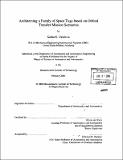Architecting a family of space tugs based on orbital transfer mission scenarios
Author(s)
Galabova, Kalina K., 1976-
DownloadFull printable version (12.31Mb)
Other Contributors
Massachusetts Institute of Technology. Dept. of Aeronautics and Astronautics.
Advisor
Olivier de Weck.
Terms of use
Metadata
Show full item recordAbstract
The consequences of satellite misplacement or collision with space debris reach far beyond the realm of money. The vast number of people affected by the loss of just one spacecraft indicates the vulnerability of our society to spacecraft failure. Thus, one of the biggest problems that satellite makers face today is the lack of a margin of error of any type. This thesis analyzes the business case for employing a special type of on-orbit servicer referred to as a space tug as an alternative to redundancy and replacement option. The main objective of a space tug is to prevent satellites from prematurely ending their missions. It was found to be more realistic to design a tug (or tugs) that service groups of satellites with similar orbital and physical characteristics, rather than to design a "monster" vehicle expected to traverse the huge distances between LEO and GEO and deal with satellites of all types and sizes. Thus, the approach of this work was based on the exploration of the entire satellite population currently in orbit around Earth and on the identification of potential target groups of satellites, along with mission scenarios for servicing each of these groups. Eight mission scenarios were identified as most necessary. Two of them-GEO communications satellite retirement and satellite rescue-were presented as case studies to illustrate the modeling approach suggested by this thesis. The ultimate objective of the research was to create a family of modular, economically feasible space tugs that used a common platform and shared various components, which would allow to provide relatively inexpensive and responsive on-demand tugging services. It was found that the optimal space tug for GEO retirement missions should be (cont.) initially parked in the GEO belt and be controlled via supervision. This space tug should have a 300-kg low capability grappling mechanism and utilize storable bipropellant (Isp = 325 sec). The maximum number of satellites the tug could visit was calculated to be 20. The minimum fee for the service was estimated to be $20.48M, and the uncertainty of cost estimations should not exceed $7.5M for the nominal case. The optimal tug for satellite rescue missions was an ion electric spacecraft parked on Earth and controlled via supervision. It was not designed as reusable, and various types of grappling mechanisms or any number of fuel tanks could be attached to it, depending on mission requirements. Both architectures could use a common bus and share the same type of grappling devices.
Description
Thesis (S.M.)--Massachusetts Institute of Technology, Dept. of Aeronautics and Astronautics, 2004. Includes bibliographical references (p. 209-215).
Date issued
2004Department
Massachusetts Institute of Technology. Department of Aeronautics and AstronauticsPublisher
Massachusetts Institute of Technology
Keywords
Aeronautics and Astronautics.